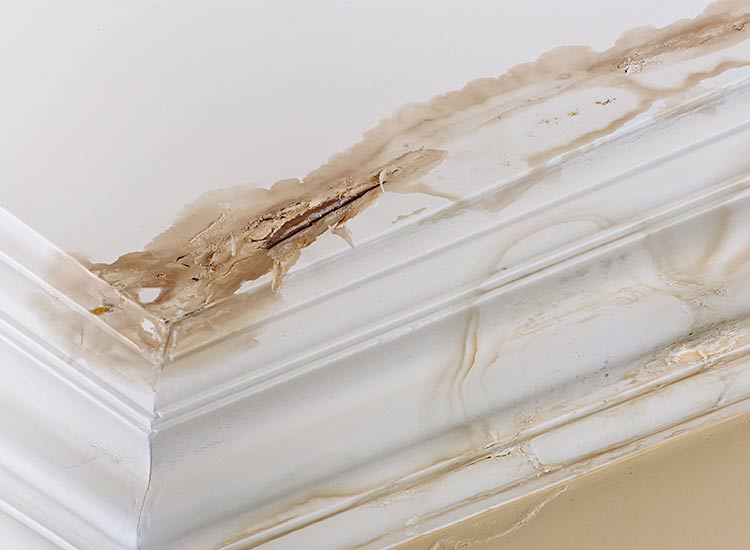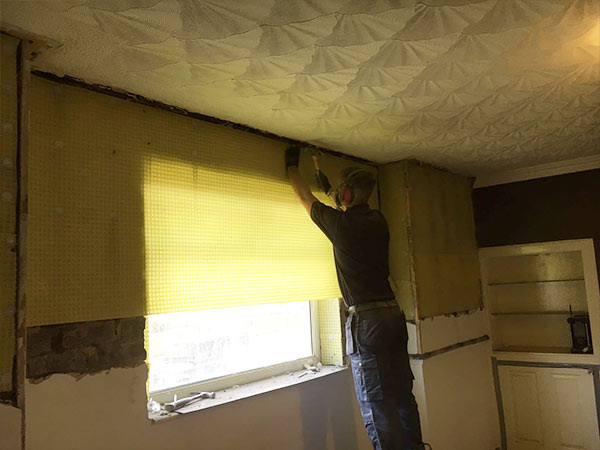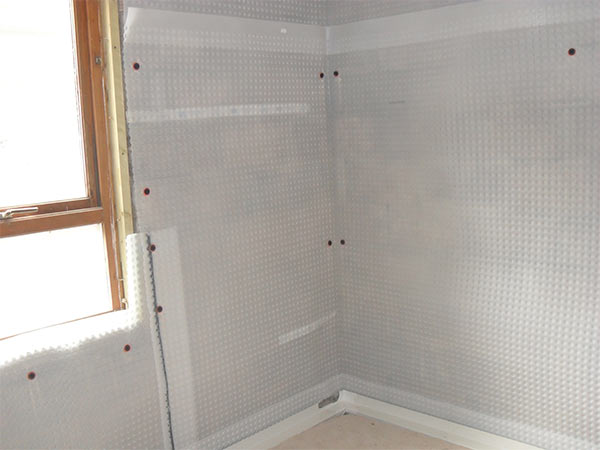Penetrating Damp Treatment

Penetrating damp is a very common damp issue which is encountered by property owners. If you have concerns that your property is suffering from damp and that you might require a penetrating damp treatment solution, then this page will provide the answers you seek. You will develop a much deeper understanding of the causes of penetrating damp and what the most suitable treatments are. Penetrating damp tends to be caused by external defects in your property. Unfortunately, this can result in internal issues within your property with visible signs of damp and deterioration of your property fabric.
Damp Proofing Your Home
Initially, our damp specialists will carry out a property survey to determine if there is a damp issue affecting your property. Upon establishing the type of damp problem you are facing we will then specify the appropriate damp treatment and action required to resolve the property damp problem. Should the problem be due to penetrating damp caused by a property defect we will detail this and recommend that the fabric defects are repaired at the earliest time to prevent further water penetrating your property. Should the penetrating damp problem be due to your masonry or render being porous then our surveyor could recommend our low cost water repellent treatment which stops water getting through the external wall however it still allows the moisture in the wall to evaporate and the wall to dry out.
Regardless of when your property was built, it can potentially suffer from penetrating damp. It is critical that the correct treatment be specified to resolve the damp problem as the wrong treatment done by yourself or others can prove considerably more expensive as the treatment can cause further damage to your property fabric and further work would be required to correctly deal with the damp problem. To the untrained eye, it can be a very challenging process to accurately identify the source of your damp issue. It can prove even more complicated with regards to selecting the appropriate penetrating damp treatment to administer. As a result, it is in your best interests to call upon the services of our qualified surveyors who will survey your property before accurately diagnosing the cause of the problem and establishing the extent of the repairs which are required. Reach out to your local branch in order to arrange a property survey or for some free advice.
How We Implement Penetrating Damp Treatment
For your peace of mind, we offer a 5-year guarantee covering our penetrating damp treatments. Our specialists will ensure that you can relax knowing that your penetrating damp troubles are a thing of the past.
The most crucial step for a successful penetrating damp treatment procedure is ensuring that the source of the moisture is identified correctly. Misdiagnosis of the type of damp affecting your property will inevitably result in the wrong work being carried out.
These are the main steps our specialists will undertake when rectifying your penetrating damp problem:
- Diagnosing the source of the moisture and recommending any relevant repairs to the external fabric
- Consult with the property owner regarding drying off the property or highlighting any internal repair works which may be required.
- Unprotected timbers within your property which have been affected by damp may become affected by rot and could require the application of an anti-fungicidal treatment.
- Richardson & Starling’s specialists will then provide the property owner with a list of additional steps which need to be taken to fully protect the property against penetrating damp

Damp Wall Treatment
Dampness on walls is a problem which is commonly encountered by property owners. However, it is important to recognise that every type of damp is considerably different and as a result the most suitable damp proofing technique to solve the specific damp problem will differ for each property.
Damp patches being visible on your internal walls is very frustrating. Not only are they visually unappealing but the damp and moisture can result in mould becoming present in your property. If any of the occupants suffer from asthma or allergies then mould can have a serious impact on their health. Furthermore, cold and damp walls may result in your rooms feeling cold and uncomfortable as the temperature can drop due to the heat escaping through the damp walls.
When any damp issue arises, it is crucial that the source is investigated thoroughly. Incorrect damp wall treatment being administered can make matters considerably worse. It is crucial that you utilise the services of a specialist at this stage who will accurately diagnose the source of the problem. If you believe the source is on the outside walls and there is evidence of defects to masonry, render, pointing, roofs, gutters or downpipes it is very likely that penetrating damp is the cause. However, the damp may be caused by other types of damp such as rising damp, condensation or plumbing leaks and these require to be investigated.

What Causes Penetrating Damp?
The most important factor with regards to rectifying a penetrating damp issue is accurately diagnosing the source of the problem. Penetrating damp can be caused by a wide variety of property defects. Some of the most common property defects resulting in penetrating damp have been listed below alongside some suggested solutions to solve these problems:
- Aging Bricks, Stonework and Render– Over time, bricks, stonework, pointing and render will lose its ability to repel water and will become more porous which allows water easier access through the external wall. The masonry, pointing and render will require to be repaired when this happens to prevent penetrating damp.
- Damaged or blocked guttering and downpipes – This is arguably the most common penetrating damp cause. With overflowing gutters allowing excess water to run down the building fabric. Fortunately, it’s also the easiest fix. Solve your issue by unblocking or repairing the downpipes and gutters.
- Window and Doors being damaged – Window, door frames and pointing can deteriorate allowing water to penetrate your property. These required to be inspected and maintained regularly.
- Damaged Roof – Defective roof coverings can cause water to penetrate your property. If you possess the relevant experience then you should replace all cracked and missing tiles or slates on your roof. Loose flashing will also need to be repaired or replaced. Most people would use a professional roofer to do this work.
These issues show why older properties tend to be the ones most commonly affected by penetrating damp. The building materials used when the property was built may have deteriorated over time or have gradually become impacted by storm damage which prevents them from doing the job they were initially intended to do. However, as previously mentioned newly built properties are not immune from penetrating damp issues either.
What Areas Can Get Affected by Penetrating Damp?
Properties which have been built with solid walls are much more likely to be affected by damp than those built with cavity wall construction. This is because cavity walls are built with the intention of leaving an air gap between the internal and external walls. This ensures that water is unable to easily gain access to the inner walls of properties.
However, cavity walls can still encounter penetrating damp issues. Wall cavities can often become clogged in places with debris left during construction which provides water with a bridge between the properties external and internal walls. Furthermore, over time many cavity walls will have had insulation inserted into the cavity to improve the thermal performance of the wall. The insulation fills the cavity gap between each wall. This means that if the external wall becomes defective and allows water to penetrate then this can cause the insulation to become damp and the moisture can affect the internal wall causing damp patches to the surface of the walls within the living area of your home.
How to Identify Penetrating Damp? What Are the Signs?
Inside your property penetrating damp tends to exhibit one symptom more than most. This is damage to the internal decoration of your property and you may see damp patches and marks staining the wall. The damp wall areas will be cold due to the penetration damp and the patches may then be affected by condensation and mould growth. Hygroscopic salts which come from the ground will not be present with penetrating damp, as this is only caused by rising damp.
What To Do Next?
Getting advice from a professional is the first thing that you should do if you are concerned that you have a penetrating damp issue affecting your property. Upon identifying symptoms of penetrating damp, it is crucial that your next step is to contact a PCA certified damp specialist.
Trying to resolve damp issues on your own can prove problematic if owners don’t possess the relevant experience. Misdiagnosis of your damp issue can be very expensive and can waste considerable time and cause more damage. Richardson & Starling’s damp specialists have been surveying properties since 1935 and accurately identify the source of your damp issue before implementing the most efficient solution for your property. Upon completion of the survey of your property, our damp specialist will provide you with a report detailing the source of the damp causing the problem and the most cost-efficient steps for you to take in order to resolve the issue.Not sure what is causing damp in your home? Contact your local branch for advice or a property survey to regain your peace of mind.
